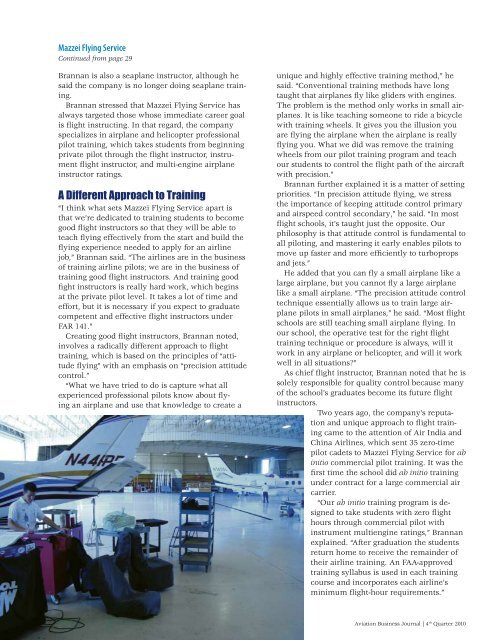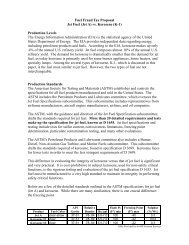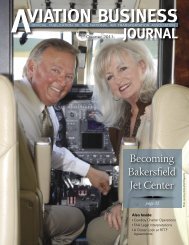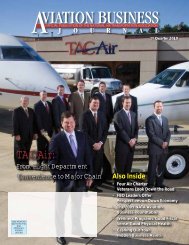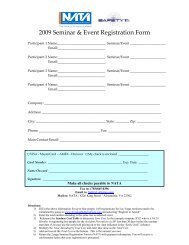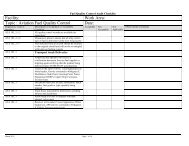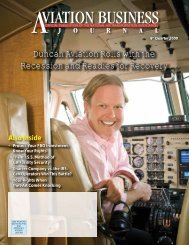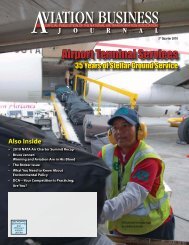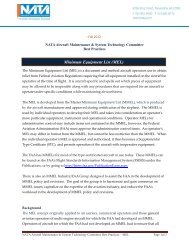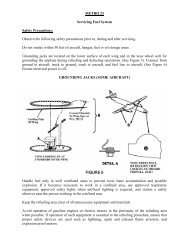Create successful ePaper yourself
Turn your PDF publications into a flip-book with our unique Google optimized e-Paper software.
<strong>Mazzei</strong> <strong>Flying</strong> <strong>Service</strong><br />
Continued from page 29<br />
Brannan is also a seaplane instructor, although he<br />
said the company is no longer doing seaplane training.<br />
Brannan stressed that <strong>Mazzei</strong> <strong>Flying</strong> <strong>Service</strong> has<br />
always targeted those whose immediate career goal<br />
is flight instructing. In that regard, the company<br />
specializes in airplane and helicopter professional<br />
pilot training, which takes students from beginning<br />
private pilot through the flight instructor, instrument<br />
flight instructor, and multi-engine airplane<br />
instructor ratings.<br />
A Different Approach to Training<br />
“I think what sets <strong>Mazzei</strong> <strong>Flying</strong> <strong>Service</strong> apart is<br />
that we’re dedicated to training students to become<br />
good flight instructors so that they will be able to<br />
teach flying effectively from the start and build the<br />
flying experience needed to apply for an airline<br />
job,” Brannan said. “The airlines are in the business<br />
of training airline pilots; we are in the business of<br />
training good flight instructors. And training good<br />
fight instructors is really hard work, which begins<br />
at the private pilot level. It takes a lot of time and<br />
effort, but it is necessary if you expect to graduate<br />
competent and effective flight instructors under<br />
FAR 141.”<br />
Creating good flight instructors, Brannan noted,<br />
involves a radically different approach to flight<br />
training, which is based on the principles of “attitude<br />
flying” with an emphasis on “precision attitude<br />
control.”<br />
“What we have tried to do is capture what all<br />
experienced professional pilots know about flying<br />
an airplane and use that knowledge to create a<br />
unique and highly effective training method,” he<br />
said. “Conventional training methods have long<br />
taught that airplanes fly like gliders with engines.<br />
The problem is the method only works in small airplanes.<br />
It is like teaching someone to ride a bicycle<br />
with training wheels. It gives you the illusion you<br />
are flying the airplane when the airplane is really<br />
flying you. What we did was remove the training<br />
wheels from our pilot training program and teach<br />
our students to control the flight path of the aircraft<br />
with precision.”<br />
Brannan further explained it is a matter of setting<br />
priorities. “In precision attitude flying, we stress<br />
the importance of keeping attitude control primary<br />
and airspeed control secondary,” he said. “In most<br />
flight schools, it’s taught just the opposite. Our<br />
philosophy is that attitude control is fundamental to<br />
all piloting, and mastering it early enables pilots to<br />
move up faster and more efficiently to turboprops<br />
and jets.”<br />
He added that you can fly a small airplane like a<br />
large airplane, but you cannot fly a large airplane<br />
like a small airplane. “The precision attitude control<br />
technique essentially allows us to train large airplane<br />
pilots in small airplanes,” he said. “Most flight<br />
schools are still teaching small airplane flying. In<br />
our school, the operative test for the right flight<br />
training technique or procedure is always, will it<br />
work in any airplane or helicopter, and will it work<br />
well in all situations?”<br />
As chief flight instructor, Brannan noted that he is<br />
solely responsible for quality control because many<br />
of the school’s graduates become its future flight<br />
instructors.<br />
Two years ago, the company’s reputation<br />
and unique approach to flight training<br />
came to the attention of Air India and<br />
China Airlines, which sent 35 zero-time<br />
pilot cadets to <strong>Mazzei</strong> <strong>Flying</strong> <strong>Service</strong> for ab<br />
initio commercial pilot training. It was the<br />
first time the school did ab initio training<br />
under contract for a large commercial air<br />
carrier.<br />
“Our ab initio training program is designed<br />
to take students with zero flight<br />
hours through commercial pilot with<br />
instrument multiengine ratings,” Brannan<br />
explained. “After graduation the students<br />
return home to receive the remainder of<br />
their airline training. An FAA-approved<br />
training syllabus is used in each training<br />
course and incorporates each airline’s<br />
minimum flight-hour requirements.”<br />
30 Aviation Business Journal | 4 th Quarter 2010


